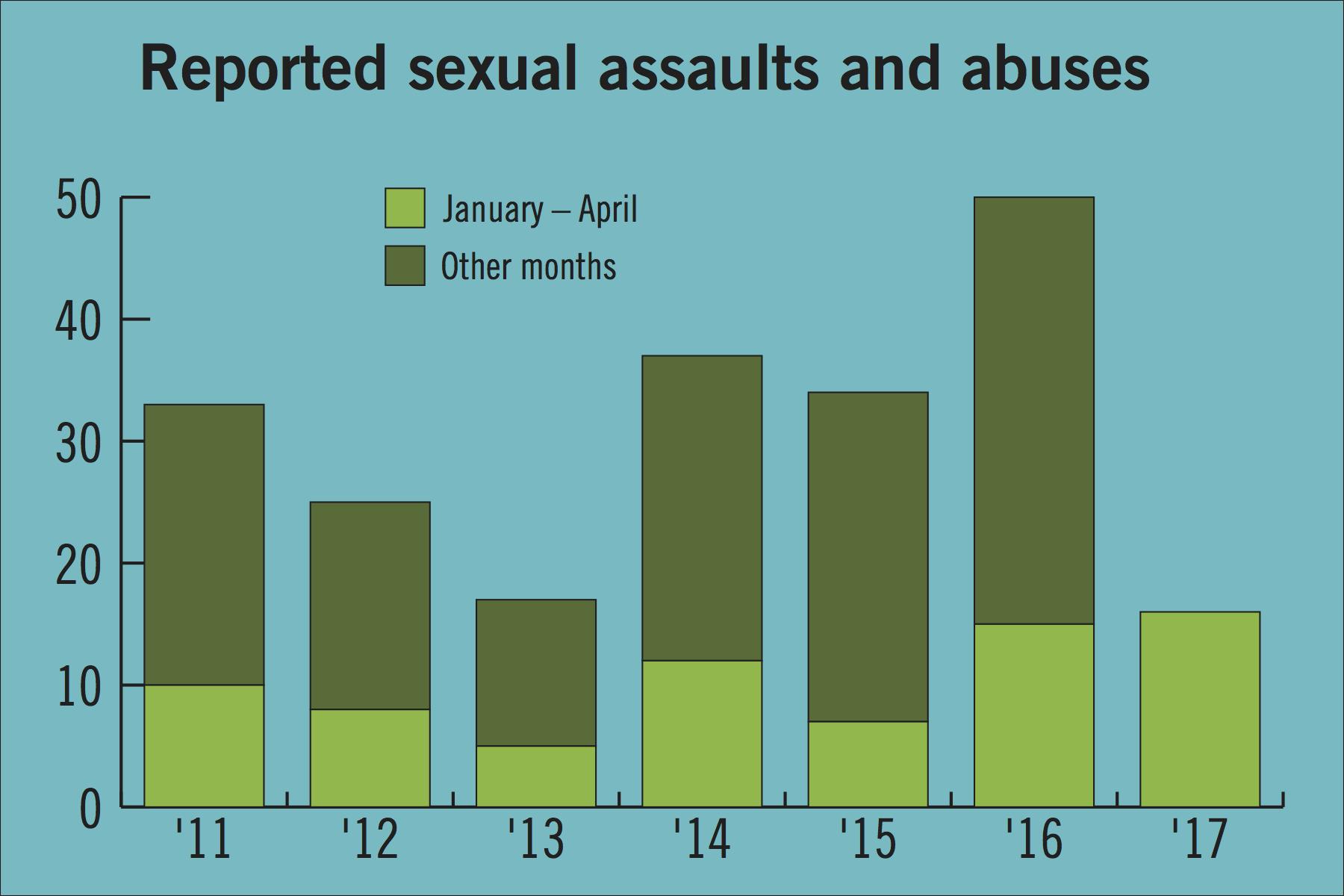
Yonah Bromberg Gaber | Graphics Eidtor
Source: University Crime Log
Reports of sexual assaults and abuses have almost tripled since 2013, which University officials attribute to an increased number of reporting options for survivors.
The number of sexual assaults and abuses increased by nearly 200 percent from 2013 to 2016, and the number of sexual assault and abuse reports jumped from 34 in 2015 to 50 in 2016 – about a 47 percent increase within one year, according to the GW crime log. Experts said GW’s increase in these reports show that students are becoming more willing to come forward to report sexual violence.
Within the first four months of 2017, 16 sexual assaults and abuses have been recorded – the most reports through April in the past six years. In 2016, 15 of these cases were reported.
University spokeswoman Maralee Csellar said more students have been reporting incidents to Campus Security Authorities, faculty or staff who have a role in campus security or overseeing campus activities, in recent years.
CSAs consist of Sexual Assault Response Consultative team members, resident assistants, residence directors, area coordinators, the Title IX office and Office of Student Rights and Responsibilities staff, she said. Reports from CSAs are automatically reported to UPD, Csellar said.
“The more reports captured, there is more ability to educate and train to deter incidences of sexual violence,” she said in an email.
Almost 77 percent of rapes in UPD’s records were reported to non-police sources in 2015, according to the Annual Security and Fire Safety Report.
Officials started requiring incoming freshmen and graduate students to complete both online and in-person sexual assault education programs in 2015.
“The training is part of the University’s comprehensive efforts to raise awareness and give students tools to help prevent sexual assault as well as provide information about resources available,” she said.
The University remodeled its sexual assault prevention training efforts in 2015 after a campus climate survey revealed that 80 percent of students did not know how to contact the Title IX office.
Csellar said UPD has not changed protocols in handling cases or added new programs for sexual assault cases.
The University Police Department started regularly distinguishing sexual assaults and abuses in April 2016, with sexual assaults referring to an unwanted sexual act and abuse referring to a person using power or authority to take advantage of a person sexually.
In 2014, GW recorded the 12th largest number of reported rapes on campuses nationwide.
Southern Methodist University’s reported sexual offenses had increased from three to 12, according to SMU’s crime log. Sexual assault reports at Georgetown University ticked up from three to four between 2015 and 2016, according to the GU’s crime log. Both universities define sexual offenses and assaults similarly to GW.
MPD reported 346 cases of sex abuse across D.C. in 2016, compared to 297 cases in 2015 – a 14 percent increase, according to MPD’s website and annual report from 2015.
Experts said that when students are given a clear set of steps to report sexual violence, crime reports may increase as more people feel comfortable going to authorities.
Jessica Davidson, the assistant managing director of End Rape On Campus, a national advocacy and support organization for survivors, said the increase could be an indication that students are more aware of their rights and the services available to them on campus.
One of the worst indicators of a campus’ climate is a low number of reported sexual assaults because it shows there is not enough campus dialogue about sexual violence, Davidson said.
“These statistics are not actually a good picture of how many assaults are happening, but they are a good picture of how comfortable students are coming forward,” she said.
Thirteen percent of students reported unwanted sexual behavior in a sexual climate survey released in 2016, compared to 24 percent in 2014.
More than 30 percent of students said they knew how to contact the Title IX office last year, compared to 20 percent in 2014.
Alan Lipman, the director of the Center for The Study of Violence in Washington, D.C., said the increase in reports of sexual assault and abuse at GW follows a national trend of more students talking about sexual assault and having more knowledge about how to deal with it.
“This isn’t necessarily true on every college campus, but they feel as if it’s safer to come forward, that they feel they’re more likely to be welcomed and believed,” he said.




